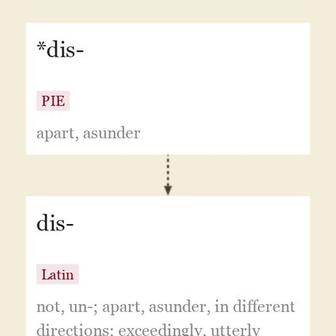dismast (v.)
“剥夺(船只)的桅杆”,1740年,来自 dis- + mast(n.1)。相关词汇: Dismasted; dismasting。
dismast 的相关词汇

拉丁语词缀,意为1. “缺乏,不”(如 dishonest); 2. “相反,做相反的事”(如 disallow); 3. “分开,离开”(如 discard),源自古法语 des- 或直接源自拉丁语 dis-,意为“分开,分离,朝不同方向,比喻为‘不,非’,也表示‘极其,完全’。在大多数有声辅音前,它被同化为 dif-,在 -f- 前被同化为 di-。
拉丁语前缀来自原始印欧语言的 *dis-,意为“分开,分离”(源自古英语 te-,古撒克逊语 ti-,古高地德语 ze-,德语 zer-)。原始印欧语言的根词是 *dwis- 的次生形式,因此与拉丁语 bis “两次”(最初为 *dvis)和 duo 有关,表示“两种方式,分开”(因此表示“分开,分离”)。
在古典拉丁语中, dis- 与 de- 相似,意思也差不多,但在后期拉丁语中, dis- 成为首选形式,并传入古法语中,成为古法语中形成复合词的形式,越来越具有否定意义(“不”)。在英语中,许多这些词最终被改回了 dis-,而在法语中,许多词被改回了 de-。通常存在混淆。
作为英语中的一个活前缀,它反转或否定了它所附着的词。有时,如意大利语中,它被缩减为 s-(如 spend, splay, sport, sdain 表示 disdain,以及姓氏 Spencer 和 Spence)。
“船上的长杆,下端固定在龙骨上,用于支撑桅杆、帆和整个索具”,古英语 mæst,源自原始日耳曼语 *mastaz(源头还包括古诺尔斯语 mastr,中古荷兰语 maste,荷兰语、丹麦语 mast,德语 Mast),源自原始印欧语 *mazdo- “一根杆子,棒子”(源头还包括拉丁语 malus “杆子”,古爱尔兰语 matan “棍子”,爱尔兰语 maide “一根棍子”,古教会斯拉夫语 mostu “桥”)。
旧船的单根桅杆是军官区和船员区的分界线,因此在戴纳的书名等中称为 before the mast,意为“担任普通水手”。
In all large vessels the masts are composed of several lengths, called lower mast, topmast, and topgallantmast. The royalmast is now made in one piece with the topgallantmast. A mast consisting of a single length is called a pole-mast. In a full-rigged ship with three masts, each of three pieces, the masts are distinguished as the foremast, the mainmast, and the mizzenmast; and the pieces as the foremast (proper), foretopmast, foretopgallantmast, etc. In vessels with two masts, they are called the foremast and mainmast; in vessels with four masts, the aftermast is called the spanker-mast or jigger-mast. [Century Dictionary, 1895]
在所有大型船只中,桅杆由几个长度组成,称为 lower mast 、topmast 和 topgallantmast。现在的皇家桅杆与顶樯桅杆是一体的。由一根长度组成的桅杆称为 pole-mast。在一个三桅全帆船中,每个桅杆由三个部分组成,分别称为 foremast 、mainmast 和 mizzenmast; 每个部分称为 foremast(正常)、foretopmast 、foretopgallantmast 等。在两桅船中,它们被称为 foremast 和 mainmast; 在四桅船中,后桅被称为 spanker-mast 或 jigger-mast。[世纪词典,1895]